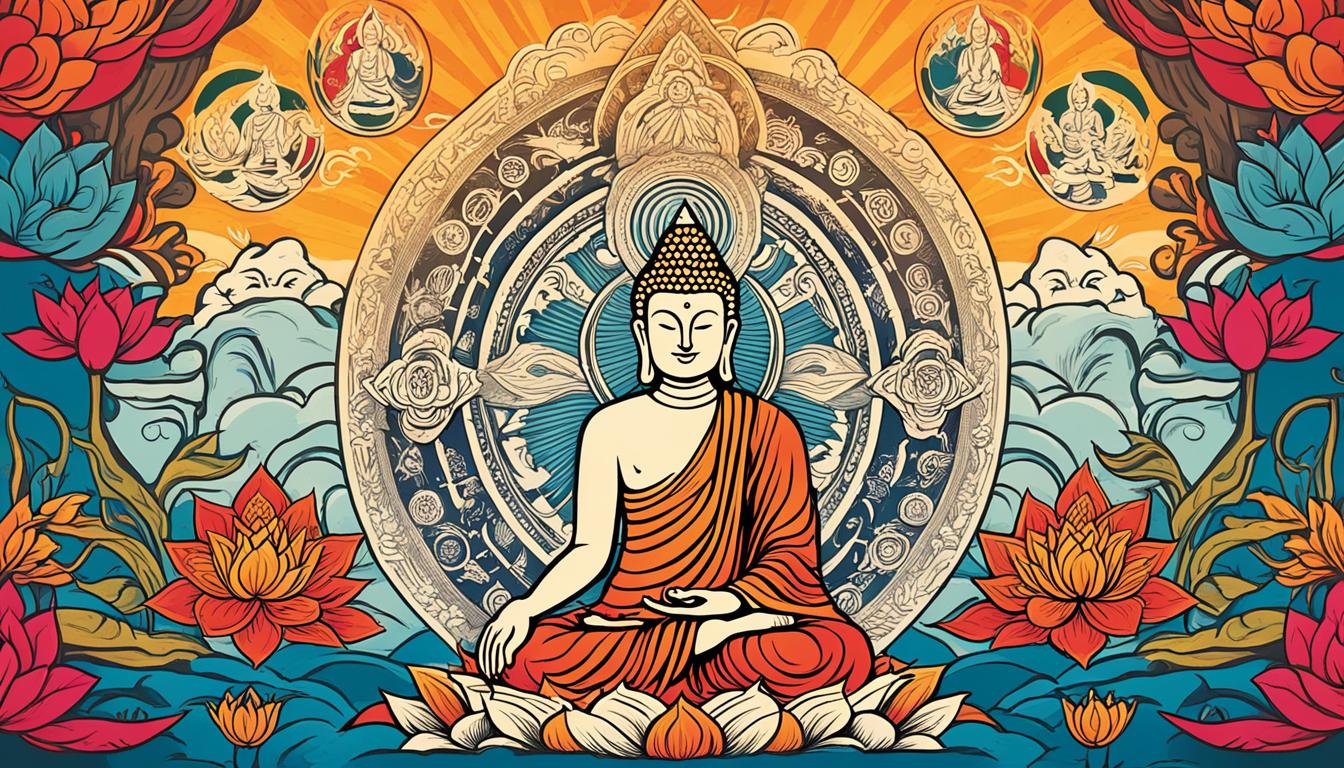“Thousands of candles can be lighted from a single candle, and the life of the candle will not be shortened. Happiness never decreases by being shared.” – Buddha
Buddhism, with its rich history and profound teachings, offers a path to enlightenment and fulfillment. As you embark on a journey through the diverse traditions and forms of Buddhism, you will discover a world of spiritual richness and wisdom that has inspired millions of people across the globe.
Key Takeaways:
- There are three main schools of Buddhism: Mahayana, Theravada, and Vajrayana.
- Mahayana Buddhism is common in East Asia, Theravada in Southeast Asia, and Vajrayana in Tibet and Nepal.
- Each school of Buddhism has its own unique practices and beliefs.
- Buddhism has adapted to different cultures, giving rise to diverse traditions.
- By exploring the various forms of Buddhism, you can find teachings that resonate with your own spiritual journey.
The Founder and Teachings of Buddhism
Siddhartha Gautama, also known as the Buddha, founded Buddhism in the 5th century B.C. After renouncing his wealth, he embarked on a spiritual quest for enlightenment and discovered profound insights into the nature of suffering and its cessation.
The Four Noble Truths:
- The truth of suffering (Dukkha): Recognizing that suffering is an inherent part of life.
- The truth of the cause of suffering (Samudaya): Understanding the origin of suffering in desires and attachment.
- The truth of the cessation of suffering (Nirodha): Realizing that suffering can be overcome by eliminating desires.
- The truth of the path to the cessation of suffering (Magga): Following the Eightfold Path to attain enlightenment and liberation from the cycle of birth and rebirth.
The Eightfold Path:
- Right View: Understanding the nature of reality and the Four Noble Truths.
- Right Intention: Cultivating wholesome intentions based on renunciation, goodwill, and compassion.
- Right Speech: Practicing truthful, kind, and non-harmful speech.
- Right Action: Observing ethical conduct by abstaining from harming living beings, stealing, and sexual misconduct.
- Right Livelihood: Engaging in a profession that is honest and supports a virtuous life.
- Right Effort: Cultivating positive mental states and abandoning negative ones.
- Right Mindfulness: Developing awareness of body, feelings, mind, and phenomena in the present moment.
- Right Concentration: Cultivating focused and undistracted states of mind through meditation.
Buddha’s teachings, known as dharma, emphasize the importance of cultivating wisdom, kindness, and compassion. These teachings provide guidance and a path to alleviate suffering and attain enlightenment.
| Founder | Teachings | Enlightenment |
|---|---|---|
| Siddhartha Gautama | Dharma – Four Noble Truths and Eightfold Path | Freedom from suffering and the cycle of rebirth |
Different Types of Buddhism
When exploring Buddhism, it becomes evident that there are various forms and schools of thought within this ancient religion. From the traditional practices of Theravada Buddhism to the compassionate ideals of Mahayana Buddhism and the esoteric teachings of Vajrayana Buddhism, each offers a unique path to enlightenment.
Theravada Buddhism
Theravada Buddhism, often referred to as the “Doctrine of the Elders,” is the oldest surviving form of Buddhism. It is primarily practiced in Southeast Asia, including countries like Thailand, Sri Lanka, and Myanmar. Theravada Buddhists emphasize the original teachings of the Buddha and focus on individual liberation through disciplined meditation and moral conduct.
Mahayana Buddhism
Mahayana Buddhism, meaning the “Great Vehicle,” is the largest school of Buddhism and is prevalent in East Asian countries such as China, Japan, and Korea. Mahayana Buddhists aspire to become bodhisattvas, enlightened beings who delay their own liberation to help others achieve enlightenment. Compassion and altruism are central to this path, with an emphasis on the interconnectedness of all sentient beings.
Vajrayana Buddhism
Vajrayana Buddhism, also known as Tantric Buddhism, is prominent in Tibet, Nepal, and surrounding regions. It is characterized by its esoteric practices, rituals, and the use of mantras and visualizations. Vajrayana practitioners believe in the transformative power of these practices in attaining enlightenment swiftly. The Dalai Lama, the spiritual leader of Tibetan Buddhism, belongs to this tradition.
| Buddhist Tradition | Key Features |
|---|---|
| Theravada Buddhism | Emphasizes original teachings Focuses on individual liberation |
| Mahayana Buddhism | Aims to become bodhisattvas Emphasizes compassion and altruism |
| Vajrayana Buddhism | Incorporates esoteric practices and rituals Believes in the swift path to enlightenment |
Each form of Buddhism offers insightful teachings and practices, allowing individuals to find a path that resonates with their spiritual journey. Whether you seek personal liberation, compassionate service to others, or the transformative power of rituals, the diverse traditions within Buddhism can guide you towards enlightenment.

Specific Traditions within Buddhism
Within each school of Buddhism, there are specific traditions that have developed with their own practices and teachings. These traditions provide unique insights and approaches to the journey of spiritual awakening. Let’s explore some of these specific traditions:
Thai Forest Tradition
The Thai Forest Tradition is a branch of Theravada Buddhism that places a particular emphasis on meditation and the direct application of the Buddha’s teachings to alleviate suffering. Forest monasteries are an integral part of this tradition, where monks and nuns live close to nature, dedicating themselves to deep contemplation and mindfulness. This tradition encourages practitioners to cultivate wisdom and compassion through rigorous meditation practice.
Burmese Buddhism
Burmese Buddhism, also known as Myanmar Buddhism, reflects the rich and diverse cultural heritage of Myanmar. This tradition highlights the significance of merit-making and the practice of insight meditation. Merit-making entails performing virtuous deeds, such as making offerings to monks and engaging in acts of kindness. Insight meditation, or Vipassana, is a profound practice that involves observing the mind and body to gain insight into the true nature of reality.
Buddhism in Sri Lanka
Sri Lanka has a long and vibrant history of Buddhism, dating back to ancient times. The Buddhist tradition in Sri Lanka places great importance on the study and application of the Buddha’s teachings. Monasteries and temples serve as centers of learning, where monks and devotees deepen their understanding of the dharma. Sri Lankan Buddhists strive to integrate the teachings into their daily lives, embracing virtues such as loving-kindness, generosity, and ethical conduct.
Insight Meditation (Vipassana)
Insight meditation, also known as Vipassana, has gained popularity not only within specific Buddhist traditions but also among practitioners from various backgrounds around the world. This meditation practice involves observing and investigating the nature of experience with mindfulness and clarity. By cultivating a deep understanding of the impermanent and interconnected nature of existence, practitioners develop insight into the causes of suffering and the path to liberation.
These specific traditions within Buddhism showcase the adaptability and richness of this ancient spiritual tradition. Each tradition offers unique practices and approaches to self-discovery, growth, and the path to enlightenment. Whether it’s the mindfulness of the Thai Forest Tradition, the insight meditation of Burmese Buddhism, the study-focused Buddhism in Sri Lanka, or the popular Vipassana practice, there is a vast treasure trove of wisdom and contemplative practices to explore on the Buddhist path.

Beliefs and Practices in Buddhism
Buddhism revolves around the concept of suffering and its causes. It offers teachings and practices that guide individuals on a path towards liberation and enlightenment. Central to Buddhist beliefs are the Four Noble Truths, which provide profound insights into the nature of suffering and the way to overcome it.
- The Truth of Suffering: Acknowledging and understanding the inevitable presence of suffering in life.
- The Truth of the Cause of Suffering: Recognizing that attachment and desire give rise to suffering.
- The Truth of the Cessation of Suffering: Realizing that by letting go of attachment and desire, suffering can be overcome.
- The Truth of the Path to the Cessation of Suffering: Following the Noble Eightfold Path to cultivate wisdom, ethical conduct, and mental discipline that leads to liberation from suffering.
To guide their behavior and cultivate positive virtues, Buddhists also follow the Five Moral Precepts:
- Refraining from killing
- Refraining from stealing
- Refraining from sexual misconduct
- Refraining from lying
- Refraining from using drugs or alcohol
By adhering to these precepts, individuals strive to create a harmonious and compassionate society for themselves and others.
Meditation is a cornerstone practice in Buddhism, serving as a means to cultivate mindfulness, deepen self-awareness, develop concentration, and enhance wisdom. Through meditation, practitioners learn to observe their thoughts and emotions without attachment, leading to a deeper understanding of their true nature. It is through this practice that Buddhists aim to transcend the self and achieve enlightenment.
In Buddhism, there is no belief in a supreme deity or creator. Instead, the focus is on self-transformation and the individual’s own journey towards enlightenment. Buddhists place great importance on personal responsibility and the power of one’s own actions in shaping their present and future.

| Beliefs and Practices in Buddhism | Description |
|---|---|
| Four Noble Truths | Insights into the nature of suffering and the path to liberation |
| Five Moral Precepts | Guidelines for ethical conduct |
| Meditation | A practice to cultivate mindfulness, wisdom, and compassion |
| No Belief in a Supreme Deity | Focus on self-transformation and personal responsibility |
Sacred Texts and Figures in Buddhism
In Buddhism, there are important sacred texts and revered figures that hold great significance in the practice and beliefs of Buddhists worldwide.
The Tipitaka: The Buddhist Holy Book
The Tipitaka, also known as the “three baskets,” is considered the Buddhist holy book. It contains the earliest and most important teachings of the Buddha. This sacred text is divided into three sections: the Vinaya Pitaka, which outlines the monastic rules and discipline; the Sutta Pitaka, which contains the discourses of the Buddha; and the Abhidhamma Pitaka, which offers profound analysis and philosophical interpretation of the Buddha’s teachings.

The Dharma: Emphasizing Virtues and Wisdom
The dharma, a fundamental concept in Buddhism, refers to the teachings and principles of the Buddha. It encompasses the path to enlightenment and the understanding of reality. The dharma emphasizes cultivating virtues such as wisdom, compassion, mindfulness, and ethical conduct. Buddhists believe that by following the dharma, they can attain liberation from suffering and achieve spiritual enlightenment.
The Dalai Lama: Spiritual Leader and Reincarnation
The Dalai Lama is a revered figure in Tibetan Buddhism and serves as the spiritual leader of Tibet. Believed to be the reincarnation of past lamas, the Dalai Lama embodies compassion, wisdom, and the pursuit of enlightenment. His teachings and guidance inspire millions of followers around the world. The Dalai Lama’s steadfast commitment to promoting peace, compassion, and understanding has earned him global recognition and admiration.
Conclusion
Buddhism is a rich and diverse spiritual tradition that encompasses a multitude of beliefs, practices, and forms. From Theravada to Mahayana to Vajrayana, there are various paths that individuals can explore on their own spiritual journey. The teachings of the Buddha have spread across the world, influencing millions of people and offering profound insights into personal and societal harmony.
One of the remarkable aspects of Buddhism is its spiritual diversity. With its myriad forms, Buddhism provides individuals with the freedom to choose a path that resonates with their own beliefs and aspirations. Whether you are drawn to mindfulness and meditation, cultivating compassion and loving-kindness, or seeking wisdom to navigate modern challenges, Buddhism offers valuable teachings for personal growth and development.
By embracing the different forms of Buddhism and engaging with its practices and philosophies, you have the opportunity to deepen your understanding of the world and yourself. Through mindfulness, compassion, and self-transformation, Buddhism offers a path towards greater happiness, inner peace, and spiritual fulfillment. So, explore the beautiful tapestry of Buddhism’s spiritual diversity and discover the transformative power it holds for your journey.
FAQ
How many forms of Buddhism are there?
Buddhism encompasses various forms and traditions, including Theravada, Mahayana, and Vajrayana, each with its own unique practices and beliefs.
What are the different types of Buddhism?
The three main types of Buddhism are Theravada, Mahayana, and Vajrayana. Theravada is common in Southeast Asia, Mahayana in East Asia, and Vajrayana in Tibet and Nepal.
Who is the founder of Buddhism and what are its teachings?
Buddhism was founded by Siddhartha Gautama, also known as the Buddha. His teachings revolve around the Four Noble Truths, which explain the nature of suffering, and the Eightfold Path, which leads to enlightenment through ethical conduct, mental discipline, and wisdom.
Are there specific traditions within Buddhism?
Yes, there are specific traditions within Buddhism, such as the Thai Forest Tradition, Burmese Buddhism, Buddhism in Sri Lanka, and Insight Meditation, which emphasize different practices and approaches to the Buddha’s teachings.
What are the beliefs and practices in Buddhism?
Buddhists believe in the Four Noble Truths and follow the Five Moral Precepts, which include refraining from killing, stealing, sexual misconduct, lying, and using drugs or alcohol. They practice meditation to cultivate mindfulness, wisdom, and compassion.
Are there any sacred texts and figures in Buddhism?
Buddhism has sacred texts such as the Tipitaka, also known as the “three baskets,” which contains the earliest Buddhist teachings. The dharma, which refers to the Buddha’s teachings, emphasizes virtues and wisdom. The Dalai Lama is a highly revered figure in Tibetan Buddhism and is believed to be a reincarnation of past lamas.
What is the conclusion about the forms of Buddhism?
Buddhism encompasses a wide range of beliefs, practices, and traditions. With its diverse forms, Buddhism offers individuals the opportunity to explore various paths that resonate with their own spiritual journey.

